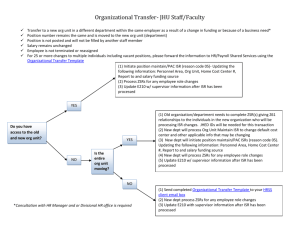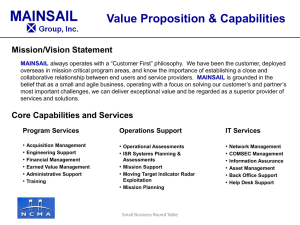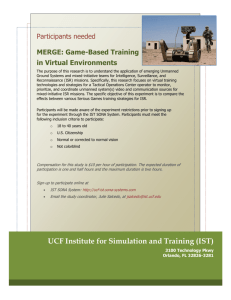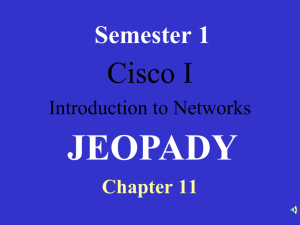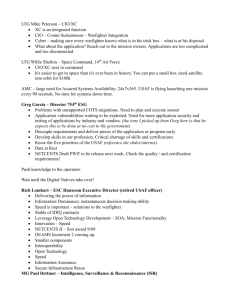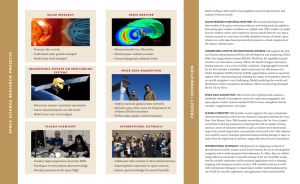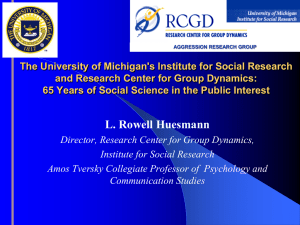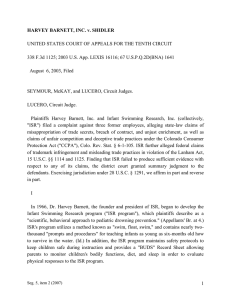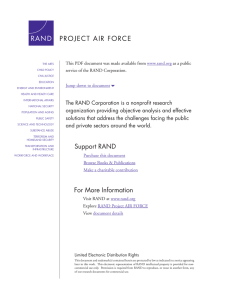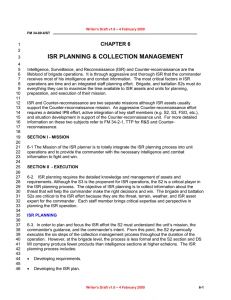Carnegie Mellon - Systems Engineering Research Center
advertisement
School of Computer Science Carnegie Mellon and SERC Bill Scherlis Professor of CS and Director ISR scherlis@cmu.edu 2 Carnegie Mellon and the SERC Status Expect to be onboard later this Fall Background Systems and software engineering at CMU The CMU Institute for Software Research in the School of Computer Science Technical specialties Areas for potential engagement Potential technical areas of focus 3 SE and software at Carnegie Mellon Computer science and systems research and education School of Computer Science (SCS) Electrical and Computer Engineering (ECE) Public policy, e-business, IT Sloan Software Industry Center (ISR) Heinz School of Public Policy and Management Tepper School of Business Software engineering and transition Software Engineering Institute (SEI) Cybersecurity CERT at the SEI CyLab CIT, CERT, Heinz, SCS Extended campuses and International collaboration Qatar Silicon Valley Korea Portugal India Australia Japan 4 SE and software at Carnegie Mellon Provost CFA Heinz SCS Tepper CyLab H&SS … … MCS … CIT SEI … Stats IS Robotics ISR HCI CS Dept Learning Math ECE Language Tech 5 CMU – What’s Special? Success in interdisciplinary research HCI, Robotics, Software engineering Engagement with challenges from industry and government NASA, DoD, NSF, NIH, etc. Public policy and technology Engineering attitude – we build things Andrew, Mach, Darpa Challenge Innovation at the boundaries NLP, model checking, software analysis, ICTD Strategic risk taking Computing, Robotics, HCII, CyLab Entrepreneurial institutional attitude 6 SCS – What’s Special? Quality #1 ranking (along with MIT, Stanford, Berkeley) Unusual strengths CMU attitude Innovation, engagement, success at boundaries Few barriers Faculty are citizens of SCS PhD students can be advised/supported nearly anywhere in SCS Joint cross-unit advising Diversity Many research styles with safe homes Diverse linkages with related and application disciplines 7 ISR – What’s Special? Scientific advances to solve practical problems Software engineering (SE) Application of CS to the engineering of software Analysis, architecture, measurement, teams, embedded, security Computer Organizations and Society (COS) Information and computing problems in society Social network analysis, security, mobility and devices, privacy Long horizon Motivated by practical problems of government and industry Scientific results with broad long-term significance Educational commitment PhD in SE, COS. Professional MS programs. Undergraduate. Organization Approx 25 faculty, 75 technical + admin staff, 200 PhD + MS students Budget is evenly split research and education 8 ISR and Research Software Engineering Research COS Research Software analysis and measurement Assurance and high confidence Architecture specification, analysis Frameworks, libraries, patterns Robustness Teams and coordination Open source, outsourcing, architecture Embedded and real-time Critical systems Social network analysis Querying and mining of graph-based models Privacy Policy specification Ambiguity and identity inference Supply chain operations Agent models for supply chain management Mobility and location Interoperation, privacy, security Cybersecurity Collaboration with industry, government Technology and policy involvement 9 ISR and Education Institute for Software Research (ISR) PhD Software Engineering PhD Computers, Organizations, Society Master of Software Engineering (MSE) Distance and Executive Programs Undergrad - SE, COS courses - SE minor PhD CS MSIT degrees - eBusiness VLIS Embedded Software Eng SE mgmt PhD ECE MBA Track in Technology Leadership 10 ISR and Education – MS, BS programs MSE in 20th year (Garlan, Rosso, Lattanze) Local and distance offerings International programs in Korea, Portugal, India Distance programs with industry Evolved best practices: faculty training, .. Practicum and studio projects with external clients Google, L3, Bosch, SEI, GM, Ford, Siemens, Intel, … Strong alumni community (more than 230 grads) MSIT-SE programs with India, South Africa (more than 140 grads) MSIT E-Business (Shamos) Learning-by-doing mentor-based instruction Practicum and studio projects with external clients MSIT Very Large Information Systems (Tomasic) Massive data repositories: analysis, access, storage, quality Links with LTI, MLD, others Software Engineering undergraduate minor Innovative undergraduate course offerings Executive programs, primarily in software engineering 11 ISR and Education – PhD Faculty Software Engineering Core Faculty William Scherlis David Garlan Mary Shaw Jim Herbsleb Jonathan Aldrich Affiliate Faculty Len Bass (SEI) Brad Meyers (HCII) Mark Paulk Mike Reiter (ECE UNC) Dan Siewiorek (HCII) Priya Narasimhan (ECE) Computation, Organizations, and Society Core Faculty Kathleen M. Carley Norman Sadeh Latanya Sweeney Lorrie Cranor Raj Reddy Dave Farber Rahul Tongia Michael Shamos Jim Herbsleb Affiliate Faculty Tuomas Sandholm Bill Hefley Jane Siegel Dave Krackhardt Jaime Carbonell 12 ISR Impact – Software Engineering Software Architecture (Garlan, Shaw) Defined the discipline Shaw and Garlan, 1996 – Software Architecture: Perspectives on an Emerging Discipline Stevens Award (Garlan) JOLT Productivity Award – Documenting Software Architecture: Views and Beyond (Garlan) Next steps Self-healing and self-managing systems Task-oriented computing (Aura, RADAR) Abstractions for end-user programming RADAR 13 ISR Impact – Software Engineering Software Analysis (Aldrich, Scherlis) Themes – scale, composition, realism Scale to existing large systems Adoptable in development practice Focused design intent analysis based verification small theorems about big programs Analysis capabilities (examples) Concurrency: shared and distributed Race conditions and thread policy Framework and API compliance (Aldrich CAREER, Dahl-Nygaard) Typestates Architecture compliance Refactoring support Impact Spinoff of Fluid technology to SureLogic 14 Assurance: Two areas of focus The system interior The system security perimeter is now the interior Diverse component sources diverse levels of trust Indicators: Reliance on provenance and insider trust Analysis must focus at composition points and APIs Information flows. Protocol compliance. Concurrent and distributed systems Intermittent corruption and deadlock Defies conventional testing and inspection Current focus: Outsource or “play the odds” Analysis must effectively address concurrency Scale motivates complex memory models Distributed and shared memory systems Observability challenges Process Thread 1 State 1 Thread 2 State 2 State 1+2 15 Areas of focus in this report 1. Cloud monitoring 2. Safe concurrency 3. Assurance of safety and security for concurrent software Difficult for testing, inspection, heuristic methods Sound static and dynamic methods Sound analysis based on abstract interpretation Dynamic analysis, monitoring Diverse components 4. Tighter iteration from development to operations and back Dynamic analysis targeted monitoring High performance dynamic analysis and monitoring for existing complex applications Focus on access and protection of critical state Apps are more aggregated and more diversely sourced Increased focus on APIs, framework interfaces, “interoperation” Static analysis for compliance with API rules Information flows and encapsulation, resource usage, etc. Bug forensics • Team servers capture rich data for secure software devt • Complex hybrid queries of code, architecture, and developer roles 16 ISR Impact – SE / COS Conway’s Law (Herbsleb) Relating project structure and organizational structure How to modularize projects and tasks Best developers (rapid resolution) coordinate better Defects 1 Density of constraints 2 Distribution of densely constrained decisions A Coordination breakdowns Increased calendar time Backtracking Increased effort Hypotheses: 1A 1B 1C 2A 2B 2C Open Source Ecologies (Herbsleb) Productivity Quality Coordination, etc. 17 ISR Impact – COS Social Networks (Carley) Featured in IEEE Spectrum Featured in NY Times Magazine “Year in Ideas” 3 best paper awards Applied graph theory, data mining Diverse applications Law enforcement Terrorism, intelligence Engineering teams Data Privacy (Sweeney) Identity Angel (alert when private info appears on web) Created k-anonymity Influenced federal health information privacy rules 18 Example areas for engagement Technology and practices Software assurance practices, tools, and field trials Scale (composition) and adoptability (usability, incrementality) Improved measurement techniques and tools to support teams, process, etc Supply-chain issues (team, architecture, Conway's Law) Sourcing, communication Architecture and process Dynamism, scale, compliance Software and associated systems challenges related to modern platforms Multicore and distributed concurrent Large-scale data-intensive Cloud infrastructure and systems Human systems integration – architectural perspective Educational innovation Professional and executive curriculum MSE now in its 20th year Many additional professional MS degrees Innovative undergraduate software engineering curriculum Didactic and project courses 19 Thrust and focus areas Enterprise responsiveness Collaboration Modeling Resilient system Producibility Parsimony Strategic assessment Basic systems science Composition System conceptualization Validation Transformation Human capital Collaboration and education Acceleration Dispersion Program management Assessment Teambuilding SoS, enterprises Services Life cycle processes Life cycle models Balance Architecting 20
